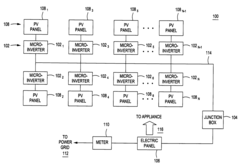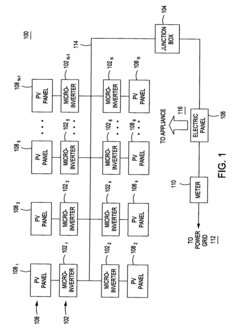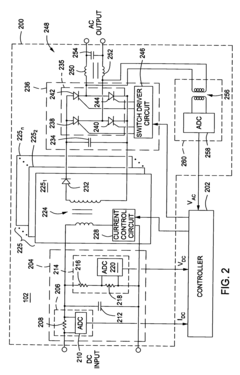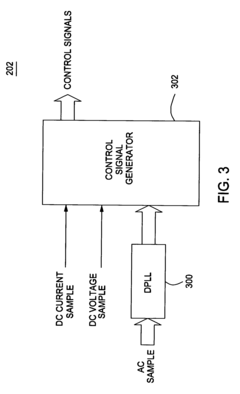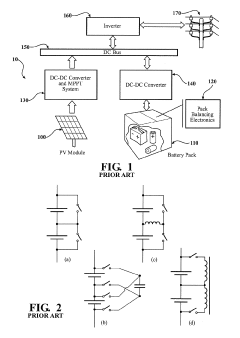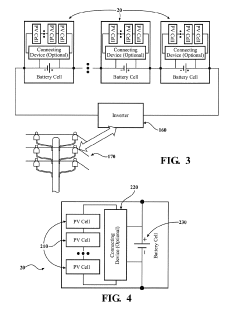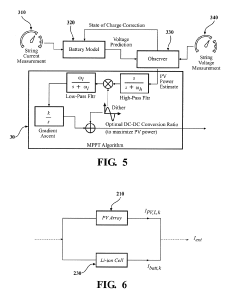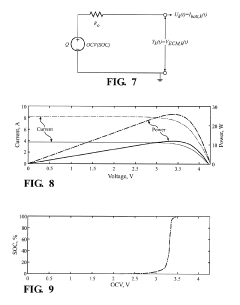How to Select Advanced Inverters for Solar Farms?
JUL 17, 202510 MIN READ
Generate Your Research Report Instantly with AI Agent
Patsnap Eureka helps you evaluate technical feasibility & market potential.
Solar Inverter Evolution and Objectives
Solar inverter technology has undergone significant evolution since its inception, driven by the rapid growth of the solar energy industry. The journey began with simple, grid-tied inverters that converted DC power from solar panels to AC power for the grid. These early inverters were relatively inefficient and had limited functionality.
As solar farms grew in scale and complexity, the demand for more advanced inverter technologies increased. This led to the development of string inverters, which offered improved efficiency and easier maintenance. The next major leap came with the introduction of central inverters, capable of handling higher power outputs and providing more sophisticated grid management features.
In recent years, the focus has shifted towards smart inverters with advanced grid support capabilities. These modern inverters can actively participate in grid stability, voltage regulation, and frequency control. They also offer enhanced monitoring and communication features, allowing for better integration with smart grid systems.
The current trend in solar inverter technology is moving towards modular, scalable solutions that can adapt to the evolving needs of large-scale solar farms. These advanced inverters incorporate cutting-edge power electronics, artificial intelligence, and IoT connectivity to optimize energy production and grid interaction.
The primary objectives driving the evolution of solar inverters for large-scale farms include maximizing energy yield, improving grid stability, reducing operational costs, and enhancing overall system reliability. There is a growing emphasis on developing inverters that can handle higher DC input voltages, which allows for more efficient system designs and reduced balance-of-system costs.
Another key objective is to improve the power density of inverters, enabling more compact and cost-effective installations. This is particularly important for utility-scale solar farms where space optimization is crucial. Additionally, there is a push towards developing inverters with advanced fault detection and predictive maintenance capabilities to minimize downtime and maximize the lifetime value of solar assets.
As the solar industry continues to mature, the selection of advanced inverters for solar farms has become a critical factor in project success. The objectives now extend beyond mere power conversion to include grid support services, energy storage integration, and smart energy management. Future inverters are expected to play a pivotal role in enabling flexible and resilient renewable energy systems, capable of adapting to the dynamic needs of modern power grids.
As solar farms grew in scale and complexity, the demand for more advanced inverter technologies increased. This led to the development of string inverters, which offered improved efficiency and easier maintenance. The next major leap came with the introduction of central inverters, capable of handling higher power outputs and providing more sophisticated grid management features.
In recent years, the focus has shifted towards smart inverters with advanced grid support capabilities. These modern inverters can actively participate in grid stability, voltage regulation, and frequency control. They also offer enhanced monitoring and communication features, allowing for better integration with smart grid systems.
The current trend in solar inverter technology is moving towards modular, scalable solutions that can adapt to the evolving needs of large-scale solar farms. These advanced inverters incorporate cutting-edge power electronics, artificial intelligence, and IoT connectivity to optimize energy production and grid interaction.
The primary objectives driving the evolution of solar inverters for large-scale farms include maximizing energy yield, improving grid stability, reducing operational costs, and enhancing overall system reliability. There is a growing emphasis on developing inverters that can handle higher DC input voltages, which allows for more efficient system designs and reduced balance-of-system costs.
Another key objective is to improve the power density of inverters, enabling more compact and cost-effective installations. This is particularly important for utility-scale solar farms where space optimization is crucial. Additionally, there is a push towards developing inverters with advanced fault detection and predictive maintenance capabilities to minimize downtime and maximize the lifetime value of solar assets.
As the solar industry continues to mature, the selection of advanced inverters for solar farms has become a critical factor in project success. The objectives now extend beyond mere power conversion to include grid support services, energy storage integration, and smart energy management. Future inverters are expected to play a pivotal role in enabling flexible and resilient renewable energy systems, capable of adapting to the dynamic needs of modern power grids.
Solar Farm Market Demand Analysis
The global solar farm market has experienced significant growth in recent years, driven by increasing demand for clean energy and the declining costs of solar technology. As of 2021, the global solar farm market was valued at approximately $62 billion, with projections indicating continued expansion at a compound annual growth rate (CAGR) of 18.7% from 2022 to 2030. This robust growth is fueled by government initiatives, environmental concerns, and the improving cost-competitiveness of solar energy compared to traditional fossil fuels.
The demand for advanced inverters in solar farms is closely tied to this market growth. Inverters play a crucial role in converting the direct current (DC) generated by solar panels into alternating current (AC) suitable for grid integration. As solar farms increase in size and complexity, the need for more efficient, reliable, and technologically advanced inverters has become paramount.
Several key factors are driving the demand for advanced inverters in solar farms. First, the push for higher energy conversion efficiency is a primary concern for solar farm operators. Advanced inverters can achieve efficiency rates of up to 99%, significantly improving the overall performance of solar installations. This increased efficiency translates directly into higher energy yields and improved return on investment for solar farm projects.
Second, grid stability and power quality requirements are becoming more stringent as the penetration of solar energy in the grid increases. Advanced inverters offer features such as reactive power control, voltage regulation, and low voltage ride-through capabilities, which are essential for maintaining grid stability and meeting utility requirements. These features are particularly important in regions with high solar penetration or weak grid infrastructure.
Third, the trend towards larger solar farms necessitates inverters with higher power ratings and improved reliability. Utility-scale solar projects now commonly exceed 100 MW in capacity, requiring inverters that can handle higher power outputs while maintaining performance and longevity. Advanced inverters with modular designs and enhanced cooling systems are better equipped to meet these demands.
Furthermore, the integration of energy storage systems with solar farms is creating new opportunities for advanced inverters. Hybrid inverters capable of managing both solar and battery systems are gaining traction, as they enable better grid integration and provide additional revenue streams through services like peak shaving and frequency regulation.
The market demand for advanced inverters is also influenced by the increasing focus on smart grid technologies and digitalization. Inverters with advanced monitoring, communication, and control capabilities are essential for optimizing solar farm performance and enabling seamless integration with smart grid systems. This trend is driving the development of inverters with enhanced data analytics, remote diagnostics, and predictive maintenance features.
In conclusion, the market demand for advanced inverters in solar farms is robust and multifaceted, driven by the overall growth of the solar energy sector and the evolving requirements of modern solar installations. As the industry continues to mature, the selection of appropriate advanced inverters will remain a critical factor in maximizing the performance, reliability, and profitability of solar farm projects.
The demand for advanced inverters in solar farms is closely tied to this market growth. Inverters play a crucial role in converting the direct current (DC) generated by solar panels into alternating current (AC) suitable for grid integration. As solar farms increase in size and complexity, the need for more efficient, reliable, and technologically advanced inverters has become paramount.
Several key factors are driving the demand for advanced inverters in solar farms. First, the push for higher energy conversion efficiency is a primary concern for solar farm operators. Advanced inverters can achieve efficiency rates of up to 99%, significantly improving the overall performance of solar installations. This increased efficiency translates directly into higher energy yields and improved return on investment for solar farm projects.
Second, grid stability and power quality requirements are becoming more stringent as the penetration of solar energy in the grid increases. Advanced inverters offer features such as reactive power control, voltage regulation, and low voltage ride-through capabilities, which are essential for maintaining grid stability and meeting utility requirements. These features are particularly important in regions with high solar penetration or weak grid infrastructure.
Third, the trend towards larger solar farms necessitates inverters with higher power ratings and improved reliability. Utility-scale solar projects now commonly exceed 100 MW in capacity, requiring inverters that can handle higher power outputs while maintaining performance and longevity. Advanced inverters with modular designs and enhanced cooling systems are better equipped to meet these demands.
Furthermore, the integration of energy storage systems with solar farms is creating new opportunities for advanced inverters. Hybrid inverters capable of managing both solar and battery systems are gaining traction, as they enable better grid integration and provide additional revenue streams through services like peak shaving and frequency regulation.
The market demand for advanced inverters is also influenced by the increasing focus on smart grid technologies and digitalization. Inverters with advanced monitoring, communication, and control capabilities are essential for optimizing solar farm performance and enabling seamless integration with smart grid systems. This trend is driving the development of inverters with enhanced data analytics, remote diagnostics, and predictive maintenance features.
In conclusion, the market demand for advanced inverters in solar farms is robust and multifaceted, driven by the overall growth of the solar energy sector and the evolving requirements of modern solar installations. As the industry continues to mature, the selection of appropriate advanced inverters will remain a critical factor in maximizing the performance, reliability, and profitability of solar farm projects.
Current Inverter Technology Landscape
The current inverter technology landscape for solar farms is characterized by rapid advancements and diversification. Central inverters have long been the standard for large-scale solar installations, offering high power capacity and cost-effectiveness. However, string inverters are gaining traction due to their flexibility and improved monitoring capabilities. The market is also seeing the emergence of multi-level inverters, which promise higher efficiency and power quality.
Modern inverters are incorporating advanced features such as reactive power control, grid support functions, and enhanced communication protocols. These capabilities allow solar farms to better integrate with the grid and comply with increasingly stringent regulatory requirements. The trend towards higher DC/AC ratios is driving the development of inverters with wider operating voltage ranges and higher power densities.
Efficiency remains a key focus, with the latest inverters boasting peak efficiencies above 99%. This improvement is largely due to the adoption of wide-bandgap semiconductors like silicon carbide (SiC) and gallium nitride (GaN). These materials enable higher switching frequencies, reduced losses, and more compact designs.
Smart inverter technology is becoming increasingly prevalent, featuring sophisticated monitoring and control systems. These smart inverters can provide real-time data on performance, predict maintenance needs, and optimize energy production based on weather forecasts and grid conditions. Some advanced models even incorporate machine learning algorithms to continuously improve their operation.
The integration of energy storage systems with solar inverters is another significant trend. Hybrid inverters capable of managing both solar PV and battery systems are gaining popularity, offering increased energy independence and grid stability. This convergence is particularly important for microgrids and off-grid applications.
Modular inverter designs are also emerging, allowing for easier scalability and maintenance. These systems consist of multiple smaller inverter units that can be easily added or replaced, reducing downtime and improving overall system reliability.
As solar farms grow in size and complexity, there is an increasing focus on centralized plant controllers that can manage multiple inverters as a single entity. These controllers optimize the performance of the entire solar farm, balancing output across different inverters and responding to grid requirements more effectively.
The inverter market is seeing a shift towards more ruggedized designs capable of withstanding harsh environmental conditions. This includes improved thermal management systems, corrosion-resistant materials, and enhanced protection against dust and moisture, all crucial for ensuring long-term reliability in diverse climates.
Modern inverters are incorporating advanced features such as reactive power control, grid support functions, and enhanced communication protocols. These capabilities allow solar farms to better integrate with the grid and comply with increasingly stringent regulatory requirements. The trend towards higher DC/AC ratios is driving the development of inverters with wider operating voltage ranges and higher power densities.
Efficiency remains a key focus, with the latest inverters boasting peak efficiencies above 99%. This improvement is largely due to the adoption of wide-bandgap semiconductors like silicon carbide (SiC) and gallium nitride (GaN). These materials enable higher switching frequencies, reduced losses, and more compact designs.
Smart inverter technology is becoming increasingly prevalent, featuring sophisticated monitoring and control systems. These smart inverters can provide real-time data on performance, predict maintenance needs, and optimize energy production based on weather forecasts and grid conditions. Some advanced models even incorporate machine learning algorithms to continuously improve their operation.
The integration of energy storage systems with solar inverters is another significant trend. Hybrid inverters capable of managing both solar PV and battery systems are gaining popularity, offering increased energy independence and grid stability. This convergence is particularly important for microgrids and off-grid applications.
Modular inverter designs are also emerging, allowing for easier scalability and maintenance. These systems consist of multiple smaller inverter units that can be easily added or replaced, reducing downtime and improving overall system reliability.
As solar farms grow in size and complexity, there is an increasing focus on centralized plant controllers that can manage multiple inverters as a single entity. These controllers optimize the performance of the entire solar farm, balancing output across different inverters and responding to grid requirements more effectively.
The inverter market is seeing a shift towards more ruggedized designs capable of withstanding harsh environmental conditions. This includes improved thermal management systems, corrosion-resistant materials, and enhanced protection against dust and moisture, all crucial for ensuring long-term reliability in diverse climates.
Advanced Inverter Selection Criteria
01 Advanced inverter design and topology
Modern inverter designs focus on improving efficiency, reducing size, and enhancing performance. This includes novel circuit topologies, advanced semiconductor technologies, and innovative control strategies to optimize power conversion and grid integration.- Advanced inverter design and topology: Modern inverter designs focus on improving efficiency, reducing size, and enhancing performance. This includes novel circuit topologies, advanced semiconductor technologies, and innovative control strategies to optimize power conversion and grid integration.
- Grid integration and smart functionalities: Advanced inverters incorporate features for seamless grid integration, including voltage and frequency regulation, reactive power support, and islanding detection. Smart functionalities enable communication with grid operators and other distributed energy resources for improved system stability and efficiency.
- Power optimization and maximum power point tracking: Advanced inverters employ sophisticated algorithms and control techniques to optimize power output from renewable energy sources. This includes advanced maximum power point tracking (MPPT) methods, adaptive control strategies, and real-time monitoring to maximize energy harvest under varying environmental conditions.
- Reliability and fault tolerance: Enhancing inverter reliability and fault tolerance is crucial for advanced systems. This involves implementing redundant components, advanced thermal management, fault detection and diagnosis algorithms, and self-healing capabilities to ensure continuous operation and minimize downtime.
- Energy storage integration and management: Advanced inverters are designed to seamlessly integrate with energy storage systems, enabling functionalities such as peak shaving, load shifting, and backup power. Sophisticated energy management algorithms optimize the interaction between renewable sources, storage, and the grid to enhance overall system performance and flexibility.
02 Grid integration and smart functionality
Advanced inverters incorporate features for seamless grid integration, including reactive power support, voltage regulation, and fault ride-through capabilities. They also offer smart functionalities such as remote monitoring, data analytics, and adaptive control for improved grid stability and energy management.Expand Specific Solutions03 Energy storage integration
Modern inverters are designed to interface with energy storage systems, enabling bidirectional power flow and optimizing the use of renewable energy sources. This integration allows for enhanced grid support, peak shaving, and improved overall system efficiency.Expand Specific Solutions04 Reliability and fault tolerance
Advanced inverters incorporate features to enhance reliability and fault tolerance, such as redundant components, self-diagnostic capabilities, and advanced protection mechanisms. These improvements lead to increased system uptime and reduced maintenance requirements.Expand Specific Solutions05 Modular and scalable designs
Modern inverter architectures often employ modular and scalable designs, allowing for easier customization, maintenance, and system expansion. This approach enables the development of inverters suitable for a wide range of applications, from residential to utility-scale installations.Expand Specific Solutions
Key Solar Inverter Manufacturers
The solar inverter market for advanced inverters in solar farms is in a growth phase, driven by increasing demand for renewable energy solutions. The market size is expanding rapidly, with projections indicating significant growth in the coming years. Technologically, advanced inverters are evolving quickly, with companies like Enphase Energy, SMA Solar Technology, and Huawei Digital Power Technologies leading innovation. These firms are developing more efficient, intelligent, and grid-friendly inverters. The competitive landscape is diverse, including established players and emerging companies, each striving to enhance inverter performance, reliability, and integration with smart grid systems. As the technology matures, we're seeing a trend towards higher power densities, improved efficiency, and advanced grid support features.
Enphase Energy, Inc.
Technical Solution: Enphase Energy specializes in microinverter technology for solar farms. Their advanced inverters use a distributed architecture, where each solar panel has its own small inverter. This approach maximizes energy production by allowing each panel to operate independently, reducing the impact of shading or panel mismatch. Enphase's IQ8 microinverters incorporate grid-forming technology, enabling them to form a microgrid and provide power even during grid outages[1]. The company's Enphase Energy System integrates solar, battery storage, and software for comprehensive energy management[2].
Strengths: High efficiency, panel-level optimization, and enhanced reliability. Weaknesses: Higher initial cost compared to string inverters, and more complex installation process.
SMA Solar Technology AG
Technical Solution: SMA Solar Technology offers a range of central and string inverters for large-scale solar farms. Their Sunny Central UP inverter is designed specifically for utility-scale projects, with power ratings up to 4.6 MVA[3]. SMA's inverters incorporate advanced grid management functions, including dynamic grid support and fault ride-through capabilities. The company's SMA ShadeFix optimization technology maximizes energy production in partial shading conditions. SMA also provides monitoring and control solutions through their ennexOS platform, allowing for seamless integration of various energy assets[4].
Strengths: Robust design for utility-scale projects, advanced grid support features, and comprehensive monitoring solutions. Weaknesses: May have higher upfront costs for smaller installations.
Innovative Inverter Technologies
Method and apparatus for converting direct current to alternating current
PatentActiveUS20110012429A1
Innovation
- A micro-inverter system with multiple power stages and a controller that dynamically selects the appropriate power stages and operational modes based on DC input power, switching between flyback, interleaved flyback, and quasi-resonant modes to optimize conversion efficiency, ensuring maximum power point tracking and phase synchronicity with the grid.
Self-balancing photovoltaic energy storage system and method
PatentActiveUS20190181646A1
Innovation
- A self-balancing PV energy storage system with hybrid cells that use a model-based MPPT algorithm and extremum-seeking control to optimize solar power generation, reducing the reliance on traditional power electronics by directly measuring current and voltage across each PV array and adjusting the DC-DC conversion ratio, thereby enabling high-voltage battery pack operation and minimizing heat dissipation.
Grid Integration Challenges
The integration of large-scale solar farms into existing power grids presents significant challenges that must be addressed to ensure reliable and efficient operation. One of the primary concerns is the intermittent nature of solar power generation, which can lead to voltage fluctuations and power quality issues. Advanced inverters play a crucial role in mitigating these challenges by providing grid support functions and enhancing overall system stability.
Voltage regulation is a key challenge in grid integration, as solar farms can cause voltage rises during periods of high generation and low demand. Advanced inverters equipped with reactive power control capabilities can help maintain voltage levels within acceptable ranges by dynamically adjusting their reactive power output. This feature is particularly important in weak grid areas where voltage stability is more susceptible to fluctuations.
Frequency regulation is another critical aspect of grid integration. Traditional power systems rely on the inertia of large rotating generators to maintain frequency stability. However, solar farms lack this inherent inertia, potentially leading to frequency deviations during sudden changes in power output. Advanced inverters with synthetic inertia and fast frequency response capabilities can help mitigate this issue by quickly adjusting their active power output to support grid frequency.
Fault ride-through capability is essential for maintaining grid stability during short-term disturbances. Advanced inverters must be able to remain connected and continue operating during voltage sags or swells, helping to prevent cascading failures and supporting grid recovery. This feature is particularly important as the penetration of solar power increases, making the grid more sensitive to disturbances.
Harmonics and power quality management are also significant challenges in solar farm integration. The switching operations of inverters can introduce harmonics into the grid, potentially affecting other connected equipment. Advanced inverters with built-in harmonic filters and power quality improvement features can help mitigate these issues, ensuring compliance with grid codes and standards.
Anti-islanding protection is a critical safety feature that prevents solar farms from continuing to energize a portion of the grid that has been disconnected from the main power system. Advanced inverters must incorporate robust anti-islanding detection and protection mechanisms to ensure the safety of maintenance personnel and prevent damage to grid infrastructure.
As the penetration of solar power increases, grid operators face challenges in managing the variability and uncertainty of solar generation. Advanced inverters with forecasting capabilities and smart grid communication interfaces can provide valuable data to grid operators, enabling more efficient dispatch and management of grid resources.
In conclusion, selecting advanced inverters for solar farms requires careful consideration of these grid integration challenges. The chosen inverters must not only provide efficient power conversion but also offer a range of grid support functions to address voltage and frequency regulation, fault ride-through, power quality, and safety concerns. By selecting inverters with these advanced capabilities, solar farm developers can contribute to a more stable and resilient power grid while maximizing the integration of renewable energy resources.
Voltage regulation is a key challenge in grid integration, as solar farms can cause voltage rises during periods of high generation and low demand. Advanced inverters equipped with reactive power control capabilities can help maintain voltage levels within acceptable ranges by dynamically adjusting their reactive power output. This feature is particularly important in weak grid areas where voltage stability is more susceptible to fluctuations.
Frequency regulation is another critical aspect of grid integration. Traditional power systems rely on the inertia of large rotating generators to maintain frequency stability. However, solar farms lack this inherent inertia, potentially leading to frequency deviations during sudden changes in power output. Advanced inverters with synthetic inertia and fast frequency response capabilities can help mitigate this issue by quickly adjusting their active power output to support grid frequency.
Fault ride-through capability is essential for maintaining grid stability during short-term disturbances. Advanced inverters must be able to remain connected and continue operating during voltage sags or swells, helping to prevent cascading failures and supporting grid recovery. This feature is particularly important as the penetration of solar power increases, making the grid more sensitive to disturbances.
Harmonics and power quality management are also significant challenges in solar farm integration. The switching operations of inverters can introduce harmonics into the grid, potentially affecting other connected equipment. Advanced inverters with built-in harmonic filters and power quality improvement features can help mitigate these issues, ensuring compliance with grid codes and standards.
Anti-islanding protection is a critical safety feature that prevents solar farms from continuing to energize a portion of the grid that has been disconnected from the main power system. Advanced inverters must incorporate robust anti-islanding detection and protection mechanisms to ensure the safety of maintenance personnel and prevent damage to grid infrastructure.
As the penetration of solar power increases, grid operators face challenges in managing the variability and uncertainty of solar generation. Advanced inverters with forecasting capabilities and smart grid communication interfaces can provide valuable data to grid operators, enabling more efficient dispatch and management of grid resources.
In conclusion, selecting advanced inverters for solar farms requires careful consideration of these grid integration challenges. The chosen inverters must not only provide efficient power conversion but also offer a range of grid support functions to address voltage and frequency regulation, fault ride-through, power quality, and safety concerns. By selecting inverters with these advanced capabilities, solar farm developers can contribute to a more stable and resilient power grid while maximizing the integration of renewable energy resources.
Inverter Efficiency Optimization
Inverter efficiency optimization is a critical aspect of solar farm design and operation, directly impacting the overall performance and profitability of the system. Advanced inverters play a crucial role in maximizing energy yield and minimizing losses throughout the power conversion process.
One of the primary considerations in inverter efficiency optimization is the selection of appropriate power electronics components. Modern inverters utilize high-performance semiconductors, such as silicon carbide (SiC) or gallium nitride (GaN) devices, which offer superior switching characteristics and lower conduction losses compared to traditional silicon-based components. These advanced materials enable higher switching frequencies, reduced thermal losses, and improved overall efficiency.
Topology selection is another key factor in optimizing inverter efficiency. Multi-level inverter designs, such as neutral point clamped (NPC) or cascaded H-bridge configurations, can significantly reduce harmonic distortion and switching losses. These topologies allow for better utilization of semiconductor devices and enable higher power density, making them particularly suitable for large-scale solar farm applications.
Advanced control algorithms play a vital role in maximizing inverter efficiency across varying operating conditions. Maximum power point tracking (MPPT) algorithms ensure optimal energy extraction from solar panels, while intelligent power factor correction techniques minimize reactive power losses. Adaptive control strategies that dynamically adjust inverter parameters based on real-time operating conditions can further enhance overall system efficiency.
Thermal management is crucial for maintaining high inverter efficiency over extended periods. Advanced cooling techniques, such as liquid cooling or phase-change materials, help dissipate heat more effectively, reducing temperature-related losses and extending the lifespan of critical components. Intelligent thermal management systems that actively monitor and regulate operating temperatures can optimize performance while minimizing energy consumption for cooling.
Integration of energy storage systems with advanced inverters can significantly improve overall system efficiency. Hybrid inverters capable of managing both solar power generation and battery storage enable smoother power output, reduce grid interaction losses, and optimize energy utilization during periods of low solar irradiance or high demand.
Lastly, the implementation of advanced monitoring and diagnostics systems is essential for maintaining peak inverter efficiency throughout the solar farm's operational lifetime. Real-time performance monitoring, predictive maintenance algorithms, and remote diagnostics capabilities enable proactive identification and resolution of efficiency-related issues, minimizing downtime and maximizing energy yield.
One of the primary considerations in inverter efficiency optimization is the selection of appropriate power electronics components. Modern inverters utilize high-performance semiconductors, such as silicon carbide (SiC) or gallium nitride (GaN) devices, which offer superior switching characteristics and lower conduction losses compared to traditional silicon-based components. These advanced materials enable higher switching frequencies, reduced thermal losses, and improved overall efficiency.
Topology selection is another key factor in optimizing inverter efficiency. Multi-level inverter designs, such as neutral point clamped (NPC) or cascaded H-bridge configurations, can significantly reduce harmonic distortion and switching losses. These topologies allow for better utilization of semiconductor devices and enable higher power density, making them particularly suitable for large-scale solar farm applications.
Advanced control algorithms play a vital role in maximizing inverter efficiency across varying operating conditions. Maximum power point tracking (MPPT) algorithms ensure optimal energy extraction from solar panels, while intelligent power factor correction techniques minimize reactive power losses. Adaptive control strategies that dynamically adjust inverter parameters based on real-time operating conditions can further enhance overall system efficiency.
Thermal management is crucial for maintaining high inverter efficiency over extended periods. Advanced cooling techniques, such as liquid cooling or phase-change materials, help dissipate heat more effectively, reducing temperature-related losses and extending the lifespan of critical components. Intelligent thermal management systems that actively monitor and regulate operating temperatures can optimize performance while minimizing energy consumption for cooling.
Integration of energy storage systems with advanced inverters can significantly improve overall system efficiency. Hybrid inverters capable of managing both solar power generation and battery storage enable smoother power output, reduce grid interaction losses, and optimize energy utilization during periods of low solar irradiance or high demand.
Lastly, the implementation of advanced monitoring and diagnostics systems is essential for maintaining peak inverter efficiency throughout the solar farm's operational lifetime. Real-time performance monitoring, predictive maintenance algorithms, and remote diagnostics capabilities enable proactive identification and resolution of efficiency-related issues, minimizing downtime and maximizing energy yield.
Unlock deeper insights with Patsnap Eureka Quick Research — get a full tech report to explore trends and direct your research. Try now!
Generate Your Research Report Instantly with AI Agent
Supercharge your innovation with Patsnap Eureka AI Agent Platform!
